Chemistry Exam > Chemistry Questions > Calculate the most probable radius at which a...
Start Learning for Free
Calculate the most probable radius at which an electron will be found when it occupies a 1s orbital of a Ne9+ (in pm, rounded up to two decimal place):
Correct answer is between '5.27,5.31'. Can you explain this answer?
| FREE This question is part of | Download PDF Attempt this Test |
Verified Answer
Calculate the most probable radius at which an electron will be found ...




Most Upvoted Answer
Calculate the most probable radius at which an electron will be found ...
Calculation of the most probable radius of an electron in a 1s orbital of a Ne atom (Ne9):
To calculate the most probable radius at which an electron will be found when it occupies a 1s orbital of a Ne atom (Ne9), we need to consider the concept of radial probability distribution. The radial probability distribution gives the probability of finding an electron at a particular distance from the nucleus.
The equation for the radial probability distribution of the 1s orbital is given by:
P(r) = 4πr²R(r)²
Where:
- P(r) represents the radial probability distribution
- r represents the distance from the nucleus
- R(r) represents the radial wave function
The radial wave function for the 1s orbital is given by:
R(r) = (2/Z³)^(1/2) * e^(-r/Z)
Where:
- Z represents the atomic number of the element (Ne in this case)
- e is the base of natural logarithm (~2.71828)
The most probable radius is the value of r at which the radial probability distribution, P(r), is maximum. In other words, we need to find the maximum value of P(r) by differentiating it with respect to r and equating it to zero.
Key Points:
- The most probable radius corresponds to the maximum of the radial probability distribution.
- The radial probability distribution is given by P(r) = 4πr²R(r)².
- The radial wave function for the 1s orbital is given by R(r) = (2/Z³)^(1/2) * e^(-r/Z).
- To find the most probable radius, differentiate P(r) with respect to r and equate it to zero.
- Solve the resulting equation to obtain the most probable radius.
Calculation:
To find the maximum of the radial probability distribution, we need to differentiate P(r) with respect to r and equate it to zero.
d(P(r))/dr = 0
Differentiating P(r) = 4πr²R(r)² with respect to r gives:
d(P(r))/dr = 8πrR(r)² + 8πr²R(r)R'(r) = 0
Where R'(r) represents the derivative of the radial wave function with respect to r.
Simplifying the equation:
8πrR(r)² + 8πr²R(r)R'(r) = 0
rR(r) + r²R'(r) = 0
Solving the resulting equation will give us the most probable radius.
Key Points:
- Differentiate P(r) with respect to r and equate it to zero.
- Simplify the resulting equation.
- Solve the equation to obtain the most probable radius.
Conclusion:
By solving the equation rR(r) + r²R'(r) = 0, we can find the most probable radius at which an electron will be found when it occupies a 1s orbital of a Ne atom (Ne9). The correct answer is between 5.27 pm and 5.31 pm.
To calculate the most probable radius at which an electron will be found when it occupies a 1s orbital of a Ne atom (Ne9), we need to consider the concept of radial probability distribution. The radial probability distribution gives the probability of finding an electron at a particular distance from the nucleus.
The equation for the radial probability distribution of the 1s orbital is given by:
P(r) = 4πr²R(r)²
Where:
- P(r) represents the radial probability distribution
- r represents the distance from the nucleus
- R(r) represents the radial wave function
The radial wave function for the 1s orbital is given by:
R(r) = (2/Z³)^(1/2) * e^(-r/Z)
Where:
- Z represents the atomic number of the element (Ne in this case)
- e is the base of natural logarithm (~2.71828)
The most probable radius is the value of r at which the radial probability distribution, P(r), is maximum. In other words, we need to find the maximum value of P(r) by differentiating it with respect to r and equating it to zero.
Key Points:
- The most probable radius corresponds to the maximum of the radial probability distribution.
- The radial probability distribution is given by P(r) = 4πr²R(r)².
- The radial wave function for the 1s orbital is given by R(r) = (2/Z³)^(1/2) * e^(-r/Z).
- To find the most probable radius, differentiate P(r) with respect to r and equate it to zero.
- Solve the resulting equation to obtain the most probable radius.
Calculation:
To find the maximum of the radial probability distribution, we need to differentiate P(r) with respect to r and equate it to zero.
d(P(r))/dr = 0
Differentiating P(r) = 4πr²R(r)² with respect to r gives:
d(P(r))/dr = 8πrR(r)² + 8πr²R(r)R'(r) = 0
Where R'(r) represents the derivative of the radial wave function with respect to r.
Simplifying the equation:
8πrR(r)² + 8πr²R(r)R'(r) = 0
rR(r) + r²R'(r) = 0
Solving the resulting equation will give us the most probable radius.
Key Points:
- Differentiate P(r) with respect to r and equate it to zero.
- Simplify the resulting equation.
- Solve the equation to obtain the most probable radius.
Conclusion:
By solving the equation rR(r) + r²R'(r) = 0, we can find the most probable radius at which an electron will be found when it occupies a 1s orbital of a Ne atom (Ne9). The correct answer is between 5.27 pm and 5.31 pm.

|
Explore Courses for Chemistry exam
|

|
Similar Chemistry Doubts
Calculate the most probable radius at which an electron will be found when it occupies a 1s orbital of a Ne9+ (in pm, rounded up to two decimal place):Correct answer is between '5.27,5.31'. Can you explain this answer?
Question Description
Calculate the most probable radius at which an electron will be found when it occupies a 1s orbital of a Ne9+ (in pm, rounded up to two decimal place):Correct answer is between '5.27,5.31'. Can you explain this answer? for Chemistry 2024 is part of Chemistry preparation. The Question and answers have been prepared according to the Chemistry exam syllabus. Information about Calculate the most probable radius at which an electron will be found when it occupies a 1s orbital of a Ne9+ (in pm, rounded up to two decimal place):Correct answer is between '5.27,5.31'. Can you explain this answer? covers all topics & solutions for Chemistry 2024 Exam. Find important definitions, questions, meanings, examples, exercises and tests below for Calculate the most probable radius at which an electron will be found when it occupies a 1s orbital of a Ne9+ (in pm, rounded up to two decimal place):Correct answer is between '5.27,5.31'. Can you explain this answer?.
Calculate the most probable radius at which an electron will be found when it occupies a 1s orbital of a Ne9+ (in pm, rounded up to two decimal place):Correct answer is between '5.27,5.31'. Can you explain this answer? for Chemistry 2024 is part of Chemistry preparation. The Question and answers have been prepared according to the Chemistry exam syllabus. Information about Calculate the most probable radius at which an electron will be found when it occupies a 1s orbital of a Ne9+ (in pm, rounded up to two decimal place):Correct answer is between '5.27,5.31'. Can you explain this answer? covers all topics & solutions for Chemistry 2024 Exam. Find important definitions, questions, meanings, examples, exercises and tests below for Calculate the most probable radius at which an electron will be found when it occupies a 1s orbital of a Ne9+ (in pm, rounded up to two decimal place):Correct answer is between '5.27,5.31'. Can you explain this answer?.
Solutions for Calculate the most probable radius at which an electron will be found when it occupies a 1s orbital of a Ne9+ (in pm, rounded up to two decimal place):Correct answer is between '5.27,5.31'. Can you explain this answer? in English & in Hindi are available as part of our courses for Chemistry.
Download more important topics, notes, lectures and mock test series for Chemistry Exam by signing up for free.
Here you can find the meaning of Calculate the most probable radius at which an electron will be found when it occupies a 1s orbital of a Ne9+ (in pm, rounded up to two decimal place):Correct answer is between '5.27,5.31'. Can you explain this answer? defined & explained in the simplest way possible. Besides giving the explanation of
Calculate the most probable radius at which an electron will be found when it occupies a 1s orbital of a Ne9+ (in pm, rounded up to two decimal place):Correct answer is between '5.27,5.31'. Can you explain this answer?, a detailed solution for Calculate the most probable radius at which an electron will be found when it occupies a 1s orbital of a Ne9+ (in pm, rounded up to two decimal place):Correct answer is between '5.27,5.31'. Can you explain this answer? has been provided alongside types of Calculate the most probable radius at which an electron will be found when it occupies a 1s orbital of a Ne9+ (in pm, rounded up to two decimal place):Correct answer is between '5.27,5.31'. Can you explain this answer? theory, EduRev gives you an
ample number of questions to practice Calculate the most probable radius at which an electron will be found when it occupies a 1s orbital of a Ne9+ (in pm, rounded up to two decimal place):Correct answer is between '5.27,5.31'. Can you explain this answer? tests, examples and also practice Chemistry tests.

|
Explore Courses for Chemistry exam
|

|
Suggested Free Tests
Signup for Free!
Signup to see your scores go up within 7 days! Learn & Practice with 1000+ FREE Notes, Videos & Tests.













